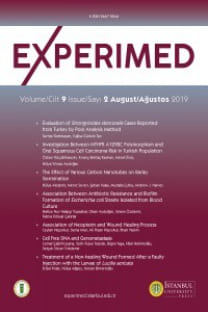Osteointegre Dental İmplant Tedavisi Gören Hastalarda IL-1 β Genotipi ve Seviyelerinin İncelenmesi
IL-1β +3953, implant, interlökin, polimorfizm
Investigation of the IL-1 β Genotype and its Levels on Patients Treated with Osteointegrated Dental Implants
IL-1β +3953, Implant, Interleukin, polymorphism,
___
- 1. Mombelli A, Van Oosten MA, Schurch E, et al. The microbiota associated with successful or failing osseointegrated titanium implants. Oral Microbiol Immunol 1987; 2: 145-51. 2. Behneke A, Behneke N, d’Hoedt B. A 5-year longitudinal study of the clinical effectiveness of ITI solid-screw implants in the treatment of mandibular edentulism. Int J Oral Maxillofac Implants 2002; 7: 799-810. 3. Ferrigno N, Laureti M, Fanali S, et al. A long-term follow-up study of non-submerged ITI implants in the treatment of totally edentulous jaws. Part I: Ten-year life table analysis of a prospective multicenter study with 1286 implants. Clin Oral Implants Res 2002; 13: 260-73. 4. Lemmerman KJ, Lemmerman NE. Osseointegrated dental implants in private practice: a long-term case series study. J Periodontol 2005; 76: 310-9. 5. Brägger U. Use of radiographs in evaluating success, stability and failure in implant dentistry. Periodontol 2000 1998; 17: 77-88. 6. Lindhe J, Berglundh T, Ericsson I, et al. Experimental breakdown of peri-implant and periodontal tissues. A study in the beagle dog. Clin Oral Implants Res 1992; 3: 9-16. 7. Esposito M, Hirsch JM, Lekholm U, et al. Biological factors contributing to failures of osseointegrated oral implants. (II). Etiopathogenesis. Eur J Oral Sci 1998; 106: 721-64. 8. Santamaria P, Gehrz RC, Bryan MK, et al. Involvement of class II MHC molecules in the LPS-induction of IL-1/TNF secretions by human monocytes. Quantitative differences at the polymorphic level. J Immunol 1989; 143: 913-22. 9. De Boever AL, De Boever JA. Early colonization of non-submerged dental implants in patients with a history of advanced aggressive periodontitis. Clin Oral Implants Res 2006; 17: 8-17. 10. Greenstein G, Hart TC. Clinical utility of a genetic susceptibility test for severe chronic periodontitis: a critical evaluation. J Am Dent Assoc 2002; 133: 452-9. 11. McGuire MK, Nunn ME. Prognosis versus actual outcome. IV. The effectiveness of clinical parameters and IL-1 genotype in accurately predicting prognoses and tooth survival. J Periodont 1997; 70: 49-56. 12. Pociot F, Molvig J, Wogensen L, et al. A TaqI polymorphism in the human interleukin-1b (IL-1b) gene correlates with IL-1b secretion in vitro. Eur J Clin Invest 1992; 22: 396-402. 13. Spiekermann H, Jansen VK, Richter EJ. A 10-year follow-up study of IMZ and TPS implants in the edentulous mandible using bar-retained overdentures. Int J Oral Maxillofac Implants 1995; 10: 231-43. 14. Branemark PI, Adell R, Albrektsson T, et al. Osseointegrated titanium fixtures in the treatment of edentulousness. Biomaterials 1983; 4: 25-8. 15. Laine ML, Leonhardt A, Roos-Jansaker A-M, et al. IL-1RN gene polymorphism is associated with peri-implantitis. Clin. Oral Impl Res 2006; 17: 380-5. 16. Kao RT, Curtis DA, Richards DW, et al. Increased interleukin-1 beta in the crevicular fluid of diseased implants. Int J Oral Maxillofac Implants 1995; 10: 696-701. 17. Panagakos FS, Aboyoussef H, Dondero R, et al. Detection and measurement of inflammatory cytokines in implant crevicular fluid: a pilot study. Int J Oral Maxillofac Implants 1996; 11: 794-9. 18. Dinarello CA. The biological properties of interleukin-1. Eur Cytokine Network 1994;5:517-531. 19. Gemmell E, Marshall RI and Seymour GJ: Cytokines and prostaglandins in immune homeostasis and tissue destruction in periodontal disease. Periodontology 2000 1997; 14: 112-43. 20. Kornman KS, Crane A, Wang HY, et al. The interleukin-1 genotype as a severity factor in adult periodontal disease. J Clin Periodontol 1997; 24: 72-7. 21. Edwards RK, Ferguson RJ, Duff P. The Interleukin-1b +3953 Single Nucleotide Polymorphism: Cervical Protein Concentration and Preterm Delivery Risk American. J Reprod Immunol 2006; 55: 259-64. 22. Pietruski JK, Pietruska MD, Stokowska W, et al. Serum levels of interleukin-1 (IL-1), interleukin-6 (IL-6) and interleukin-8 (IL-8) in patients treated with dental implants. Rocz Akad Med Bialymst 2001; 46: 28-37. 23. Sakellari D, Koukoudetsos S, Arsenakis M, et al. Prevalence of IL-1A and IL-1B polymorphisms in a Greek population. J Clin Periodontol 2003; 30: 35-41. 24. Rogers MA, Figliomeni L, Baluchova K, et al. Do interleukin-1 polymorphisms predict the development of periodontitis or the success of dental implants? J Periodontal Res 2002; 37: 37-41. 25. Feloutzis A, Lang NP, Tonetti MS, et al. IL-1 gene polymorphism and smoking as risk factors for peri-implant bone loss in a well-maintained population. Clin Oral Implants Res 2003; 14: 10-17. 26. McGuire MK, Nunn ME. Prognosis versus actual outcome. IV. The effectiveness of clinical parameters and IL-1 genotype in accurately predicting prognoses and tooth survival. J Periodontol 1999; 70: 49-56. 27. Kornman KS: Interleukin 1 genetics, inflammatory mechanisms, and nutrigenetic opportunities to modulate diseases of aging. Am J Clin Nutr 2006; 83: 475S-83S. 28. Tonetti MS. Risk factors for osseodisintegration. Periodontol 2000 1998; 17: 55-62. 29. Lindquist LW, Carlsson GE, Jemt T. Association between marginal bone loss around osseointegrated mandibular implants and smoking habits: a 10-year follow-up study. J Dent Res 1997; 76: 1667-74.
- Yayın Aralığı: Yılda 3 Sayı
- Başlangıç: 2011
- Yayıncı: İstanbul Üniversitesi
Evde Bakım Hastalarının Laboratuvar Özellikleri
Zeynep KARAALİ, Beste TACAL ASLAN, Mehmet Burak AKTUĞLU, Macit KOLDAŞ, Elif Sinem İPLİK, Bedia ÇAKMAKOĞLU
İki Tilmikosin Preparatının Koyunlarda Biyoeşdeğerliği
Osteointegre Dental İmplant Tedavisi Gören Hastalarda IL-1 β Genotipi ve Seviyelerinin İncelenmesi
Ferhat DİZEN, Uzay GÖRMÜŞ, Arzu ERGEN, Meral ÜNÜR, Elif Sinem İPLİK, Bedia ÇAKMAKOĞLU, Turgay İSBİR
Elif ŞAHİN, Nurten DAYIOĞLU, Baransel ÖKMEN, Ezgi KORKMAZ, Şevval BAYKARA, Gül BAKTIR
Resul KAHRAMAN, Veysel HANCER, Arzu ERGEN, Bedia ÇAKMAKOĞLU, Reyhan DİZ KÜÇÜKKAYA
CD247 Genine Ait rs858554 ve rs704848 Polimorfizmlerinin İmmün Trombositopeni Hastalığı ile İlişkisi
İbrahim KUTLUBAY, Elif Gülsüm ÜMİT, Jülide TOZKIR
Fatma KÖKSAL ÇAKIRLAR, Sevilay YILDIZ, Okan AYDOĞAN, Sinem ÖZDEMİR, Sercan AKYOL ÇOLAKOĞLU, Zeynep TANER, Halit TOKMAN, Nevriye GÖNÜLLÜ
